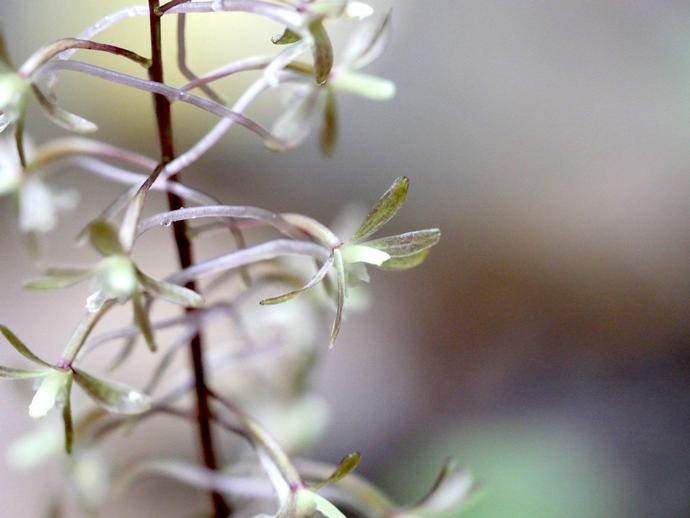August 17, 2020
While it may not be quite as striking as the pink lady's slipper orchid (Cypripedium acaule), the cranefly orchid (Tipularia discolor) is still a beautiful plant! This is the only orchid within the genus Tipularia that can be found in North America and it is mainly found in the southeast, although its range extends up into the Catskills. There are also a few isolated populations in the Great Lakes area.
Like many orchids, this one has an interesting method of pollination. The flowers are mainly pollinated by owlet moths, which visit the flowers at night to feed on the nectar. As you can see in the photos, the flowers grow slightly off-center, tilting in one direction or the other. As the moth pushes its proboscis deeper into the flower to lap up more nectar, the shape of the flower causes a pollinium (a little mass made up of multiple pollen grains) to get pushed right onto the moth's eyeball! It may seem rude to us, but it doesn't bother the moth, which then flies to another plant and transfers the pollen to a new flower.
The cranefly orchid blooms from mid-July to late August, so if you'd like to see one yourself, now is a good time to venture out into the woods (I photographed this one last Friday). Keep your eyes low to the ground; the flower spikes range in height from about five inches to 25 inches, and considering the small size of the flowers, it can be easy to miss. Also, unlike many plants, this one flowers BEFORE it grows leaves. It usually grows a single leaf in September which is gone by the spring. The leaf is green on top and purple underneath.
While these orchids are rare or threatened in several states at the edges of their range, they seem to be decently common in the woods of southwest Virginia, so keep an eye open! #BenInNature
ABOUT THIS POST
Social distancing can be difficult, but it presents a great opportunity to become reacquainted with nature. While he is working from home, Administrator of Science Ben Williams is venturing outdoors each day to record a snapshot of the unique sights that can be found in the natural world.
NATURE PHOTO IDENTIFICATIONS
If you discover something in nature that you would like help identifying, be sure to message us right here on Facebook with a picture (please include location and date of picture) and we'll have our experts help you identify it!

 Hours & Admissions
Hours & Admissions Directions
Directions

